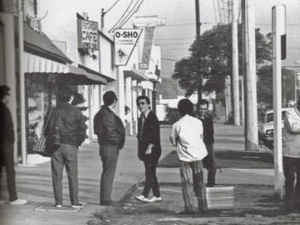Everyday America.
That’s what many of the historic Japantowns across the state have become. In 2007, the California Japantowns project identified 43 historic Japantown areas across California, but only a handful of these places still exist today as Japantowns. Most of them have turned into…Everyday America, like the San Diego Japantown (now the Gaslamp Quarter) and the Sacramento Japantown (now the Capitol Mall business district). In these former Japantown areas, instead of a Japanese grocery store, restaurant, and bonsai nursery, you’re now more likely to see a Starbucks, McDonald’s, and a new condo development. Yes, America is gradually turning into Everyday America.
Historic Sawtelle
In West Los Angeles, the Sawtelle area is another historic Japantown. Sawtelle has a rich Japanese American history dating back to the early 1900s when the Issei (first-generation) settled in the area. Unlike in San Diego and Sacramento, however, Sawtelle today still has the appearance of a Japantown, with a variety of Japanese restaurants and businesses, three neighborhood churches with large Japanese American congregations, and a community center with a Japanese language school and martial arts classes.
But, just as it did in San Diego and Sacramento, big development has now come to Sawtelle. Many long-standing Japanese American businesses, such as Yamaguchi Store and Safe & Save Market, are now gone, and many businesses that have no ties to Japanese American heritage or culture are moving into Sawtelle. And, much more development is on its way.
So, will Sawtelle gradually turn into Everyday America? Japanese Americans would be sad to see Sawtelle Japantown fade away because of the rich family and community history that would likely be forgotten. Japanese American culture would also be affected. Today, the preservation of Japanese American culture is becoming more dependent on Japantowns like Sawtelle as more and more of the new generations of Japanese Americans assimilate into mainstream America.
However, the greater threat of losing Sawtelle as a Japantown may be to the American public as a whole. Losing any ethnic community means that we are one step closer to our entire country turning into Everyday America. Many people might see this as inevitable “progress,” with the new replacing the old as we move further into the 21st century. However, the more we lose our ethnic identities, the more we become a homogenous society. And, this is NOT a good thing for us.
Inevitably, our descendants are all probably destined to look like a mixture of all ethnicities. This will be the “American” look, with everyone having light brown skin and a wide array of interethnic features. But, even though people may all look similar, does this mean that Americans should all think the same way?
America’s Strength Is Its Diversity
The answer, of course, is absolutely not. America’s true strength comes from its diversity and a society and culture in which people are encouraged to share their differences. This diversity leads to a wider range of opinions, which in turn leads to new ideas and innovation. This innovation has resulted in a continuous succession of successful business endeavors (think Google, Facebook, and Amazon) and has kept America at the economic forefront of the world.
Research has shown that diversity is a key factor in a nation’s prosperity. In business, leaders are advised to surround themselves with a diverse set of people instead of hiring all “yes men” because leadership becomes stronger with different opinions flowing across the boardroom. In a 2010 study of over 1,500 business leaders, the most important quality of a leader was found to be creativity. Innovation is the key to business success, and diversity is the key to innovation.
In education, reformers are speaking out against the practice of standardized testing because “standardized testing leads to standardized children.” They fear that schools are turning into homogenization factories that churn out robot-like graduates prepared for 20th century manufacturing work. Instead, we need graduates who think out of the box and have a diverse set of skills to prepare themselves for 21st century innovation.
Fortunately, America is one of the most diverse nations in the world because it is the melting pot of all ethnicities. Los Angeles is one of the most ethnically diverse cities in America, so that puts Sawtelle and all of our local ethnic communities at the center of the melting pot. We need to make sure that we keep these ethnic communities alive so that we can continue to be a city—and country—full of diverse backgrounds, cultures, opinions, and ideas.
Sawtelle Japantown
Keeping Sawtelle alive as a Japantown is therefore important not just for Japanese Americans but for the future of America. But, with new businesses and developers moving into the area and forcing inevitable change, how can we ensure that Sawtelle continues to exist as a Japantown in the future?
The goal will be to get all businesses, developers, residents, and visitors who come into Sawtelle to respect the fact that this place is a historic Japantown. They all must enter the community knowing that they are now a contributing member of the history, culture, and heritage of Japanese Americans. Getting Sawtelle officially recognized and “branded” as an ethnic Japantown is the first step we need to take toward achieving this goal.
The Sawtelle Japantown Association (SJA) is a group now working on this first step. The SJA is focusing on first getting the city to put up “Sawtelle Japantown” signs and then working on state and/or national recognition of Sawtelle as an official historic district. This branding of Sawtelle Japantown will be critical to raising public awareness that Sawtelle is and will always be an ethnic community and part of the diverse culture of Los Angeles.
We need to save Sawtelle Japantown. Everyday America may be nice but not at the expense of sacrificing our precious diversity.
* This article was originally published on the website of Japanese Institue of Sawtelle.
© 2014 Randall Fujimoto




